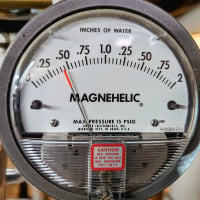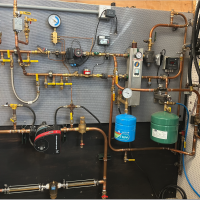Why pull through airhandlers?

I've been trying to understand this for almost 10 years now.
Why do many air handlers, if not most, use a pull through design with the blower on the supply side of the evaporator, instead of it behind the evaporator like on furnace + AC designs?
It seems like besides the airhandler having a tendency to pull air in (often hot attic air), and needing a condensate trap that can often clog it also places the blower in an extremely damp, even wet environment. Why? What is the reasoning?
Single pipe 392sqft system with an EG-40 rated for 325sqft and it's silent and balanced at all times.
Comments
-
-
You're probably right, but why are any of them pull through?
I see the same thing on minisplits, and the blower wheels often get all clogged up with dust because it's so damp and nasty.
This isn't by mistake, so I have to think there's a bunch of pros to the design, but what?
Single pipe 392sqft system with an EG-40 rated for 325sqft and it's silent and balanced at all times.
0 -
Engineers know better then us!🤬
Oversized minis build up that crap. same as oversized central units.
0 -
I understand why minisplits would, but why do oversized central units do it? The blower isn't usually variable like a mini.
Single pipe 392sqft system with an EG-40 rated for 325sqft and it's silent and balanced at all times.
0 -
-
I understand that, but that's going to be the case regardless of how the system is sized, no?
Single pipe 392sqft system with an EG-40 rated for 325sqft and it's silent and balanced at all times.
0 -
Colder air is more dense that hotter air. The blower moves more pounds of air if it is on the cold side of the equipment. A cubic foot of 40° air weighs more than a cubic foot of 80° air. and since the fan moves cubic feet of air and the actual thermodynamics of the BTUs moved by the air is a relationship of the pounds of air moved, you get more bang for your buck putting the fan in the colder air.
I thought everyone realized that.
Push air thru the furnace and pull air thru the refrigerated coil.
Why is the refrigeration coil placed on the discharge side of a furnace? It is easier. Not because it is better. And since all the ratings are based on the easier "Coil on discharge" applications, they even do it on down-flow and horizontal furnaces so they dont need two different performance specifications.
And the Engineers don't believe that we mere mortals can handle two different charts based on where the coil is located.
Edward Young Retired
After you make that expensive repair and you still have the same problem, What will you check next?
2 -
It appears quicker on oversized Systems!
0 -
Have you seen how many steam boilers are piped?
I don't blame the engineers.
I did realize about air density, but I didn't think it would matter much in this scenario, but I have a feeling you hit the nail on the head.
Single pipe 392sqft system with an EG-40 rated for 325sqft and it's silent and balanced at all times.
1 -
-
I'm going to guess such damage is rarely covered by warranty?
Single pipe 392sqft system with an EG-40 rated for 325sqft and it's silent and balanced at all times.
0 -
I believe there’s only five years on the heat exchanger in an RTU
0 -
No Engineering blame here…. The engineers have it correct most of the time (On Paper). It is us mere mortals that can't understand how to implement what they write on the paper. LOL
Now is that because the people that work in the field can't understand the language of the engineer or the engineer can't speak in a normal language that mortals can understand?
Edward Young Retired
After you make that expensive repair and you still have the same problem, What will you check next?
0 -
-
Not given enough time time to read the manual.
0 -
I never really thought about it. I always accepted it as it is. We have 29 AHU's in my building.
If I hadn't read @EdTheHeaterMan posts, I would have said it is easier to suck in air from outside, filter it, mix it with return air, condition it- then push it down the supply air duct.If pressed, I would have said the filters have a lower static across them on the suction side of the fan and last longer. The same would be true across the coils.
The air density explanation gets to the point faster.
0 -
Im wondering if its a manufacturing design philosophy.
0 -
-
The Trane air handlers have the coil on the positive side of the blower. I like that they don't require a drain trap, but that's about the only thing I like about those plastic air handlers. That design has a lot of issues, the location of the coil in relation to the blower is not one of them either.
1 -
Put the strips on the outlet of the blower but before the evap then, no?
How does Trane/AS do it?
Single pipe 392sqft system with an EG-40 rated for 325sqft and it's silent and balanced at all times.
0 -
I've heard people complain about those.
What issues do they have?
Single pipe 392sqft system with an EG-40 rated for 325sqft and it's silent and balanced at all times.
0 -
You will notice in modern AH the discharge off blower is about half the cabinet size. When pushing into a coil the airflow is uneven and will push harder thru one side. Pulling gives return air a chance to flow past coil evenly and be sucked out into the discharge side of the AH. There's other reasons such as heat strips etc but that's the main reason...... Told to me from an engineer at Carrier
1 -
not pushing through the hx of a furnace is really the reason the coil is after the hx on a furnace/ac/heat pump combo so it doesn't cause condensation in the hx, that is the real answer to this question.
0 -
-
My main problem with the TAM/Hyperion air handlers is that the units were designed without any care about ease of service. Faults codes are determined by a series of various colors of blinking tiny LEDS that are difficult to read. The location of the boards is in a bad spot. I hate the plastic cabinets and doors that always seem to be difficult to get back on for some reason. Homeowners always complain about the amount of air the cabinets leak.
They seem to have a lot of problems with the electronic expansion valves.
Thankfully I don't see very many in my area that I currently work in. When I worked in Westchester county they were more common.
1 -
-
Bob "hot rod" Rohr
trainer for Caleffi NA
Living the hydronic dream3
Categories
- All Categories
- 87.3K THE MAIN WALL
- 3.2K A-C, Heat Pumps & Refrigeration
- 61 Biomass
- 427 Carbon Monoxide Awareness
- 119 Chimneys & Flues
- 2.1K Domestic Hot Water
- 5.8K Gas Heating
- 115 Geothermal
- 165 Indoor-Air Quality
- 3.7K Oil Heating
- 76 Pipe Deterioration
- 1K Plumbing
- 6.5K Radiant Heating
- 395 Solar
- 15.6K Strictly Steam
- 3.4K Thermostats and Controls
- 56 Water Quality
- 51 Industry Classes
- 49 Job Opportunities
- 18 Recall Announcements





